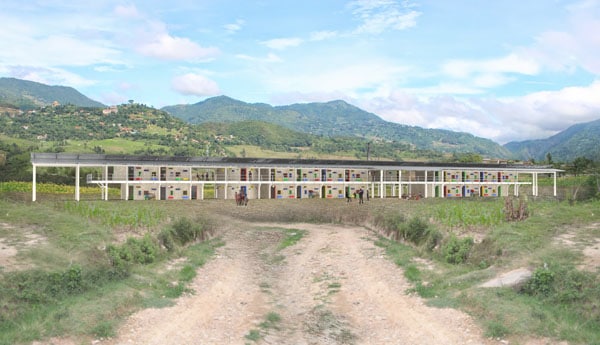On April 25, 2015, an earthquake in Nepal killed more than 8,000 people, injured 20,000+, and wreaked havoc on the South Asian country’s infrastructure—displacing thousands and wiping away important buildings like hospitals and schools. In order to help with the aftermath of this catastrophe, New York-based SHoP Architects has partnered with Kids of Kathmandu and the Asia Friendship Network (AFN) to rebuild 50 public schools in areas that saw the most devastation.
The schools will go beyond their traditional purpose, ensuring that local communities as a whole will benefit from their construction while also serving as a prototype for, hopefully, future non-governmental organizations to build full-service schools in a safe and responsible way moving forward.
Here, we look at how this partnership will get the job done—eventually impacting the lives of 10,000 children—with sustainability and safety at the top of mind.

Roofing will direct rainfall away from the courtyard for collection. One meter overhangs will protect the building from heavy monsoon showers, while a breathable underlay will promote natural ventilation. RENDERING: COURTESY OF SHOP ARCHITECTS PC

The schools will be equipped with solar electricity generation, integrated water purification systems, new kitchens, and wireless internet that will power donated computers. RENDERING: COURTESY OF SHOP ARCHITECTS PC

Designed to survive future earthquakes with concrete slab foundations and resilient steel truss roof systems, they’re also intended to serve as “safe havens” in the event of another future natural disaster or emergency. RENDERING: COURTESY OF SHOP ARCHITECTS PC

The schools, both primary and secondary, will use locally sourced earth brick construction in addition to concrete and steel, in order to maximize volunteer labor—connecting the community and allowing its members to help out. The earth brick construction also slashes energy and money spent on transportation, as the process uses soil straight from the site. RENDERING: COURTESY OF SHOP ARCHITECTS PC



CONNECT WITH SHOP ARCHITECTS: Website | Facebook | Twitter | LinkedIn
CONNECT WITH KIDS OF KATHMANDU: Website | Facebook | Twitter
CONNECT WITH ASIA FRIENDSHIP NETWORK: Website

